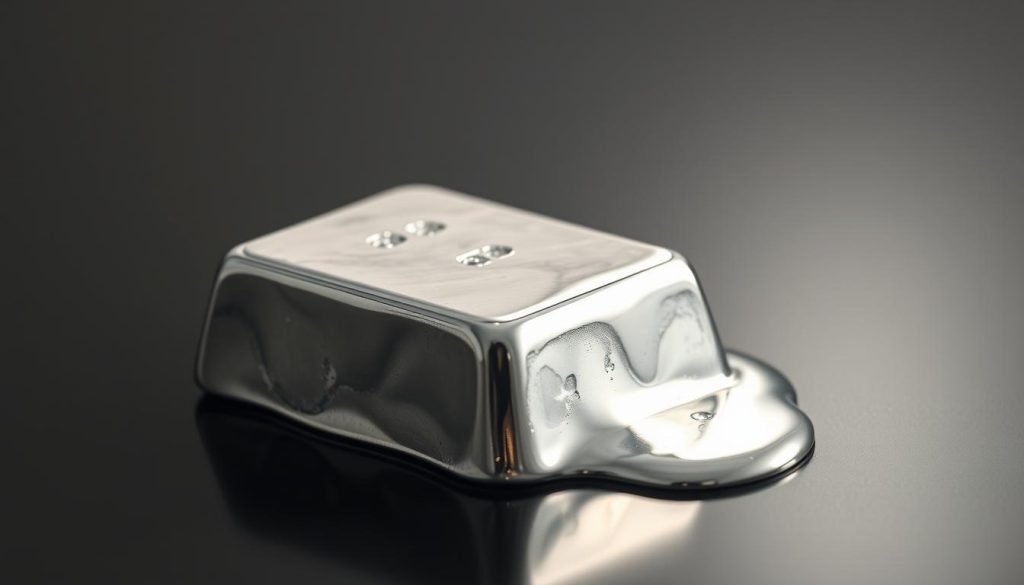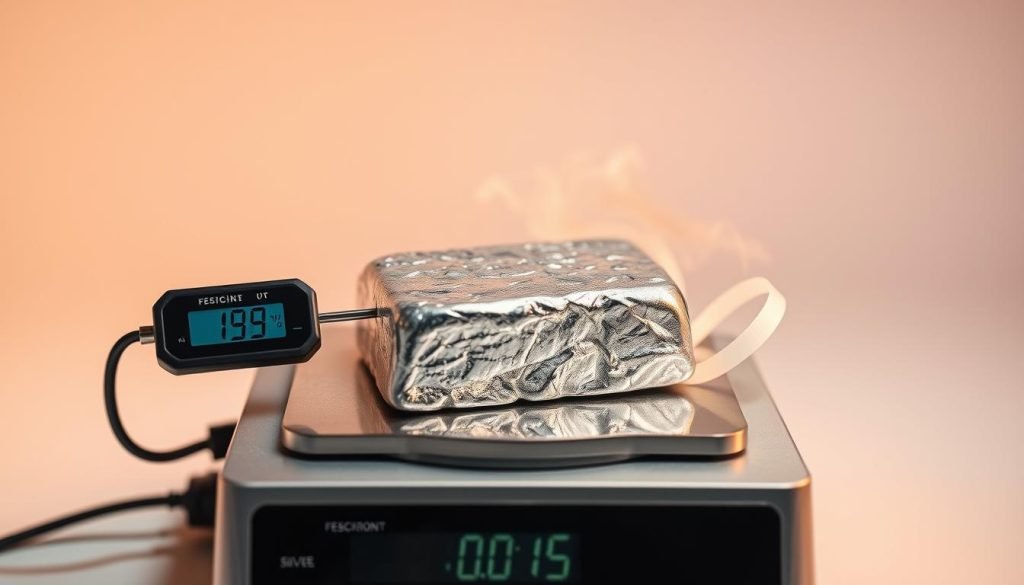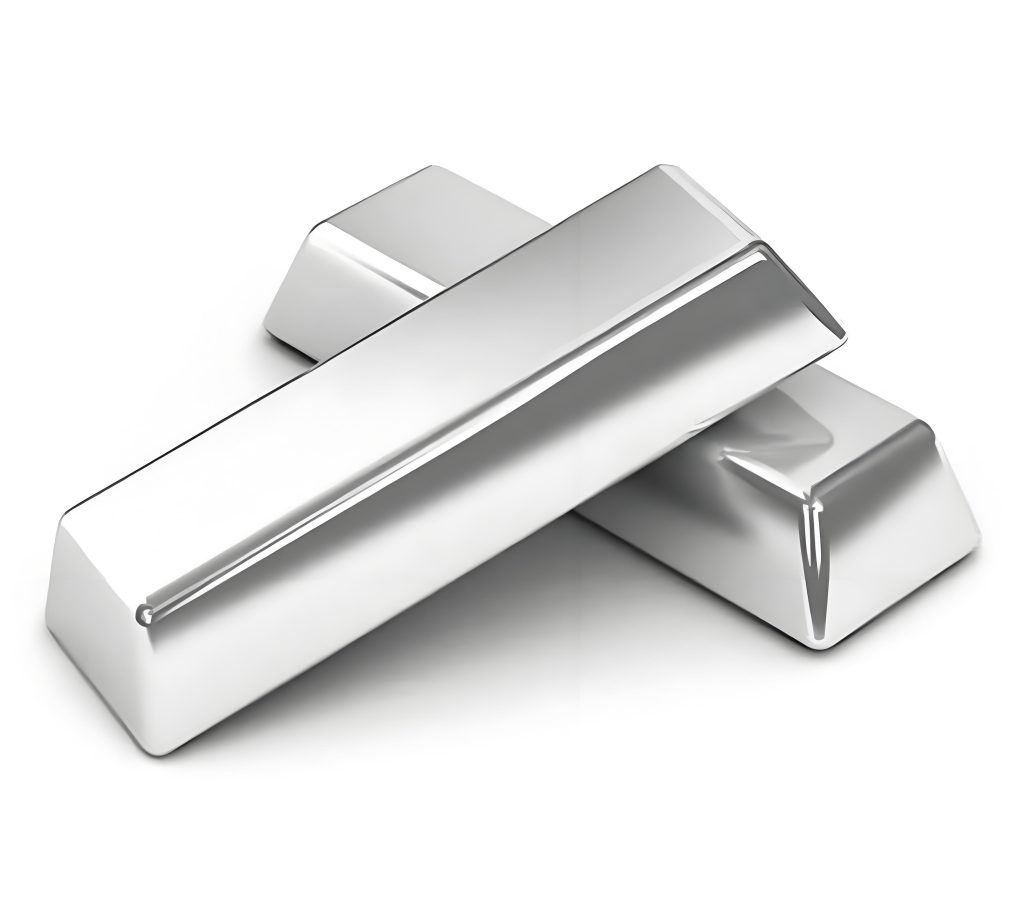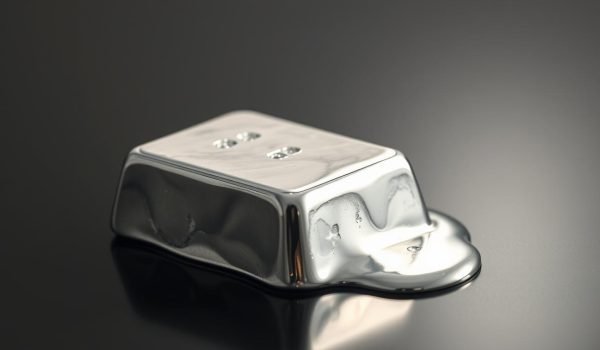Have you ever wondered what makes silver a preferred choice for various industrial applications, from electronics to jewelry making? The answer lies in its unique thermal properties, particularly its melting point.

The melting point of silver is a critical property that determines its usability in different manufacturing processes. At 961.8°C (1,763.24°F), silver requires a significant amount of heat to change from solid to liquid. This high melting temperature contributes to its remarkable heat resistance compared to other metals.
Understanding the melting properties of silver is essential for customers working with silver materials. Whether you’re manufacturing products with silver or applying silver coatings, knowing its melting point is crucial for achieving the desired outcomes.
Understanding the Melting Point of Silver
To work effectively with silver, you need to know its melting point and how it behaves under different conditions. The melting point is a critical property that determines how silver can be used in various applications, from jewelry making to industrial manufacturing.
What is Silver’s Melting Point?
Silver’s melting point is 961.8°C (1,763.2°F or 1235K). This is the temperature at which silver changes state from solid to liquid at atmospheric pressure. At this point, the solid and liquid phases of silver exist in equilibrium. Understanding this temperature is crucial for processes that involve melting silver, such as casting or soldering.
The Science Behind Silver’s Phase Change
The phase change from solid to liquid occurs at the molecular level, where the metallic bonds between silver atoms break, allowing for increased atomic mobility. Silver’s face-centered cubic crystal structure and high thermal conductivity play significant roles in its melting behavior. As silver melts, its high thermal conductivity allows heat to distribute quickly throughout the material, making it efficient for applications that require rapid heating or cooling.
Comparing silver’s melting point to its boiling point (2,162°C) illustrates the wide temperature range in which liquid silver can be worked with, offering flexibility in manufacturing processes.
Different Grades of Silver and Their Melting Points
Silver comes in various grades, each with its unique melting point influenced by its purity and alloy composition. The purity level of silver, measured in fineness, directly affects its melting point and other physical properties. Understanding these differences is crucial for selecting the appropriate silver grade for specific applications.
Fine Silver (999 Fineness)
Fine silver, with a fineness of 999, has a melting point of 961.8°C (1,763.2°F). Its high purity gives it excellent thermal conductivity, but its softness can limit some applications. Fine silver is ideal for situations where high purity is required.
Sterling Silver (925 Fineness)
Sterling silver, containing 92.5% silver and 7.5% copper, has a melting point of 893°C (1,640°F). The addition of copper improves its hardness and durability, making it the most common silver alloy used in jewelry and other applications.
Britannia Silver (958 Fineness)
Britannia silver, with a fineness of 958, melts at 940°C (1,724°F). It has a higher silver content than sterling silver, offering improved workability. This grade is often used for intricate designs and ornaments.
Silver Alloys and Their Melting Temperatures
Various silver alloys have different melting temperatures. For instance, Argentium silver (935 fineness) melts at 930°C (1,706°F), while silver solders can have melting points as low as 600-650°C (1,112-1,202°F). Manufacturers select specific silver grades based on their melting points and other properties to match particular application requirements.
Understanding the melting points of different silver grades is essential for designing manufacturing processes for silver components. By choosing the right grade, you can ensure that your final product meets the required specifications and performs as expected.
Factors That Affect Silver Melting Point

Several factors can influence the melting point of silver, making it a complex property to predict. Understanding these factors is crucial for industries that work with silver, as they directly impact the metal’s behavior during processing and application.
Purity and Alloying Elements
The purity of silver is a primary factor affecting its melting point. Higher purity silver has a more precise melting point. Alloying elements such as copper, zinc, and nickel can significantly alter silver’s melting behavior. Different elements affect the melting point to varying degrees, with some lowering it substantially.
Pressure and Environmental Conditions
Environmental pressure conditions can alter silver’s melting behavior. Increased pressure typically raises the melting point. This factor is particularly relevant in industrial processes where silver is melted under controlled conditions.
Atomic Structure and Crystal Defects
The presence of crystal defects, impurities, and grain boundaries in silver can create localized melting at temperatures below the standard melting point. These defects can significantly impact the metal’s melting behavior.
Heating Rate and Thermal Conductivity
The heating rate affects the melting process, with rapid heating potentially causing uneven melting or thermal stress in silver components. Silver’s exceptional thermal conductivity allows for quick and uniform heat distribution, influencing its melting behavior.
By understanding and controlling these factors, manufacturers can achieve optimal results when working with molten silver. This knowledge is essential for various applications, from jewelry making to industrial manufacturing.
Silver Melting Point Compared to Other Metals
Comparing the melting point of silver to other metals provides valuable insights into its potential applications. Silver’s melting point is 961.8°C, which is relatively moderate compared to other metals.
Precious Metals Comparison
When compared to other precious metals, silver has a lower melting point than gold (1,064°C) and platinum (1,768°C). This difference impacts jewelry making and investment casting processes. For instance, silver’s lower melting point makes it easier to work with when creating intricate designs.
Common Industrial Metals
Silver’s melting point is also distinct from common industrial metals. It is higher than aluminum (660.3°C) and lead (327.5°C) but lower than copper (1,084°C) and iron (1,538°C). These varying melting points determine the manufacturing approaches used for each metal. Understanding these differences helps manufacturers select the appropriate metal for specific applications based on thermal requirements.
Why Silver’s Melting Point Matters
Silver occupies a useful middle ground in terms of melting point, being higher than some metals like aluminum, making it more heat-resistant, but lower than others like copper, making it more energy-efficient to process. This characteristic makes silver particularly suitable for certain alloys and composite materials, especially in electronics where components may be exposed to high temperatures.
How to Melt Silver Safely and Effectively
Melting silver requires careful planning and the right equipment to ensure a safe and successful process. To achieve this, you need to understand the basics of silver melting and the necessary precautions to take.
Equipment Needed for Melting Silver
To melt silver, you’ll need a few essential pieces of equipment. These include a crucible, typically made of graphite or ceramic, which can withstand the high melting temperature of silver without contaminating the metal. You’ll also need a furnace or a blowtorch for heating, heat-resistant tongs for handling the molten silver, and protective gear such as goggles, gloves, and a face shield. Proper ventilation is also crucial to prevent inhaling harmful fumes.
Step-by-Step Silver Melting Process
The process of melting silver involves several steps. First, prepare your work area by clearing it of any flammable materials and ensuring good ventilation. Next, heat the silver in the crucible using a furnace or blowtorch until it reaches a temperature above its melting point (961.8°C). Monitor the temperature closely to avoid overheating. Once the silver is molten, use heat-resistant tongs to pour it into molds. Let the silver cool completely before handling it to avoid burns.
Safety Precautions and Best Practices
Safety is paramount when melting silver. Always wear protective gear, including goggles, gloves, and a face shield, to protect yourself from splashes of molten silver. Ensure your work area is free from flammable materials, as temperatures above 300°C can cause instant combustion. Be cautious when handling hot equipment and molten silver to avoid accidents.
Industrial and Practical Applications of Silver’s Melting Properties

The melting properties of silver are vital for manufacturing processes that require precision and reliability. You can leverage silver’s unique characteristics to create high-quality products across various industries.
Manufacturing and Fabrication Uses
In manufacturing, silver’s specific melting temperature enables precise processes, creating components that withstand moderate heat while maintaining excellent electrical conductivity. This property is particularly valuable in industries requiring reliable connections and durable materials.
Jewelry and Artistic Applications
The jewelry industry utilizes silver’s melting properties for casting intricate designs, creating alloys with specific characteristics, and joining components through soldering. This versatility allows artisans to craft complex pieces with precision and detail.
Electronics and High-Tech Industries
Electronics manufacturers rely on silver’s melting point and exceptional electrical conductivity to create reliable connections that withstand operational temperatures. This combination of properties makes silver an essential material in high-tech applications.
Conclusion
As we’ve explored, the melting point of silver plays a significant role in shaping its properties and applications. Understanding that silver melts at 961.8°C is crucial for optimizing manufacturing processes.
Different grades of silver, such as sterling silver, have varying melting points that affect their uses. Knowledge of factors influencing silver’s melting behavior helps ensure product quality.
By grasping the importance of silver’s melting properties, You can improve their silver-based manufacturing processes, leveraging this knowledge to drive innovation in materials science.
FAQ
What is the melting temperature of pure silver?
The melting temperature of pure silver, also known as fine silver, is approximately 1763.2°F (961.8°C).
How does the melting point of sterling silver compare to fine silver?
Sterling silver, which is 92.5% silver, has a slightly different melting point than fine silver due to the presence of alloying elements, typically copper. The melting point of sterling silver is around 1700°F (926.7°C), but it can vary depending on the specific composition.
What factors can affect the melting point of silver alloys?
The melting point of silver alloys can be influenced by the type and proportion of alloying elements, such as copper, zinc, or nickel. Additionally, factors like pressure, heating rate, and thermal conductivity can also impact the melting behavior of silver alloys.
Why is it important to know the melting point of silver in jewelry making?
Understanding the melting point of silver is crucial in jewelry making, as it allows craftsmen to work with the metal safely and effectively, creating intricate designs and shapes without damaging the material.
How does the melting point of silver compare to other precious metals like gold?
Silver has a relatively lower melting point compared to gold, which melts at around 1947.52°F (1064°C). This difference in melting points is significant in various industrial and manufacturing processes.
What safety precautions should be taken when melting silver?
When melting silver, it’s essential to wear protective gear, including heat-resistant gloves, safety glasses, and a face mask. You should also work in a well-ventilated area, away from flammable materials, and follow proper handling procedures to avoid accidents.
Can the melting point of silver be used in high-tech industries?
Yes, the unique melting properties of silver make it an ideal material for various high-tech applications, including electronics, solar panels, and conductive pastes, where its high thermal conductivity and ductility are valuable.




